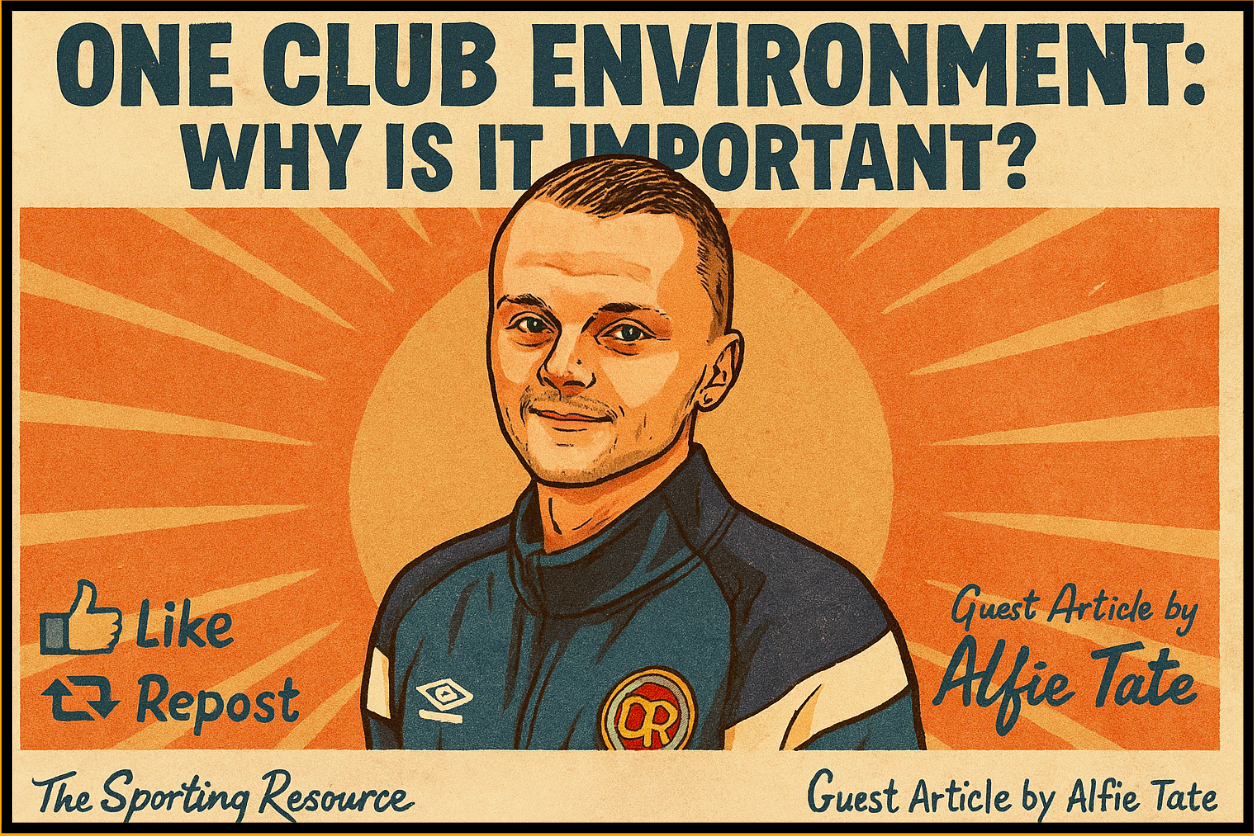I recently watched back the documentary about Sir Alex Ferguson where he was presenting to a classroom of students, stood in front of a whiteboard with a ‘hierarchy’ styled list of the people that most influence his job. He rubbed off the titles of those who didn’t directly affect his roles such as shareholders and sponsors… This was the thought process that came to my mind when Richard asked me to write about a One Club Environment for his website. I considered who are the primary people involved in creating a One Club Environment? Who has the biggest influence and who helps implement this environment to allow success?
Firstly, what is a one-club environment and why is it important? For me as a Manager who has coached and managed from Mini Kickers, Mini Soccer, Colts, Professional Academy and senior level, implementing and maintaining a one-club environment is so key to long-term success and enjoyment by those involved. It’s something you’d read in my methodology when going into a club – the environment and culture is so key to achieving your targets and objectives.
If I could summarise a one-club environment in one word, I’d probably use “Family”. Everyone has to feel a part of what’s being done, from the first-team level down to the youngest youth teams, everyone should take an interest and know what is going on at all levels. I’ve been at clubs where this has been excellent and even as a youth coach, I was welcomed and known by people in the younger age groups but also known and respected by those involved at U18’s, Reserves and first-team level. When I eventually got into the first-team level as an Assistant Manager, I felt it was important we tried to build this One Club mentality amongst the senior and youth sides. The first team was so distant from the Reserves and A-Team and nobody really knew or liked each other – even when we pulled it a bit closer by training together, having more discussions as a coaching staff and getting to know other players better, there was still a bit of conflict due to the history of what had gone on. As well as that, I was always down the ground early watching the youth team games, watching the U16’s training and helping the other senior sides with the odd coaching session. This just helped create the environment in that we felt we were all in together and shared each other’s successes and failures – like a family would.
Staff:
I feel coaches and volunteers of any club can sense and enjoy the feel of a one-club environment. I’ve briefly spoken about myself and my experiences as a youth coach – for the first team manager or Reserves Manager to take an interest is a massive boost and makes you want to push yourself to do more for your players and the club as a whole – you don’t want to let those people down.
Some people aren’t that interested or influenced by people in more senior positions which you will often find at lower-level clubs where perhaps they’re just happy to coach at the level they’re at or they’re coaching their child’s team and not as interested.
I think as well coaches can see a pathway forward in their career when there is a one-club mentality as everyone is sharing their work and progress, people in higher positions (Senior leadership or the chairman/board) recognise this work and may see fit that a certain member of staff deserves to be working in a higher position than they currently are. This is fantastic for staff/volunteers as it gives them the motivation to continue improving with the possibility of progressing in their current club.
Parents:
Now, this is arguably the most important aspect of trying to create a one-team environment within specific age groups but it’s so important that the whole club follows this for the sake of every child’s development. Parents are so vital in creating the right environment for children as the messages are often transferrable to home life so it’s important that parents get the buy-in with the club/team manager. I’ve written about the importance of parents in a child’s development before as it’s something I’m passionate about
I think some ways of getting parents involved and engaged within the team to incorporate and encourage them into that one-club mentality is firstly, to just keep in contact with them. Be organised and keep them up to date regularly, and take an interest in them as well as their child. Greet them at games and training if they stay to watch as that shows their welcomed and valued in the team/club. It’s such a simple thing to do and most people would already do it but I think just regular and organised communication with your parents through your WhatsApp group chats or face-to-face is so important.
Other methods can be arranging meetings every so often (bi-monthly) to sit down and discuss things, get stuff of their chest and show you’re taking an interest in their concerns – sometimes you don’t have to implement changes for them to gain your respect as more often they’re just appreciative of you showing an interest in their concerns.
It’s not something I have done in the past but I know of some coaches who share their session plans with their parents to keep them engaged in the process and understand the work they’re doing in training which would be transferred into matchdays.
I often find the best parents are the ones who don’t bother the manager or get involved in issues without having a genuine concern for their child or the team – they trust the coach to do their job (as that’s what they’re qualified and experienced to do) and only get involved if there is an issue with their child (unhappy, things going on at home or school).
Players
And finally, the players! The main reason why we coach and why a one-club environment is so important – is to help them thrive, to help them improve and ultimately to help them enjoy their football. They are the reason as parents and coaches we must create the right environment to help them achieve these opportunities for development and enjoyment. As young players, they possibly don’t see the environment being created by a coach without having that maturity and education of how an environment is formed by the coaches and parents – I’ve been at clubs where the older youth players (U15’s above perhaps) have got an understanding and recognise me trying to create this environment to help them develop and enjoy themselves. When they move to U18s and senior football, they’re much more understanding of the importance of the environment and setting and maintaining standards for themselves and others in the group.
This is where the environment essentially becomes player-led which is perfect from a coaching perspective. Some of the best coaches in the world still allow their environments to be player-led rather than coach-led. I was reading a study based around the Irish Rugby Union’s review of a recent tournament they had in which the players felt they had mixed messages from their management team where some games they’d be heavily player-led and would gain success in games and the players felt more relaxed and comfortable working together to achieve a common goal but when that responsibility was ‘taken away’ from management and it became more coach-led, players often felt tenser and felt like they weren’t trusted by the management – routines normally became more strict and rigid and therefore players lost a sense of creativity.
This is both the risk of heavily coach-led environments and also inconsistency in messages to the players in giving and taking away responsibility. I think the best way to create a good environment with the players is to build good individual relationships with them. This makes them feel a part of the club but also a valued individuals who will want to turn up to training as they know they’re valued but also coming to a club where it’s going to be fun. Building relationships with younger players (Say 5-11 years old) is normally done through fun, enthusiasm and engagement in my opinion. Welcoming the players to training or games with a joke or a high five can gradually help build these relationships. In the long term, players are then more willing to listen and engage in challenges and questions that you might ask them because you’ve built that relationship and trust.
In older players, this relationship can still be formed and developed through high fives, handshakes, and jokes but also by taking a more personal interest in them. Ask them how school is going, how their family is doing, and what they got up to at the weekend and just build that individual rapport with each person by taking a genuine interest in them as people and players. Often, this will help players trust you and also be more willing to listen to any advice or support you give them which can help to improve the environment.
Giving players ownership and responsibility can help develop their confidence within a team but also expresses the environment you want to create for them by making it more player-led. It also gives you the opportunity to see what types of personalities you have within a team. Who are the leaders? Who are the followers? Both are fine, but by giving this opportunity of ownership and responsibility to your players, will help you identify and recognise those who are leaders or followers.
Thank you to Richard for asking me to write for his website. If any players, coaches or parents would like any further support, information or even just a further, deeper discussion on these points, I’m more than happy to.






